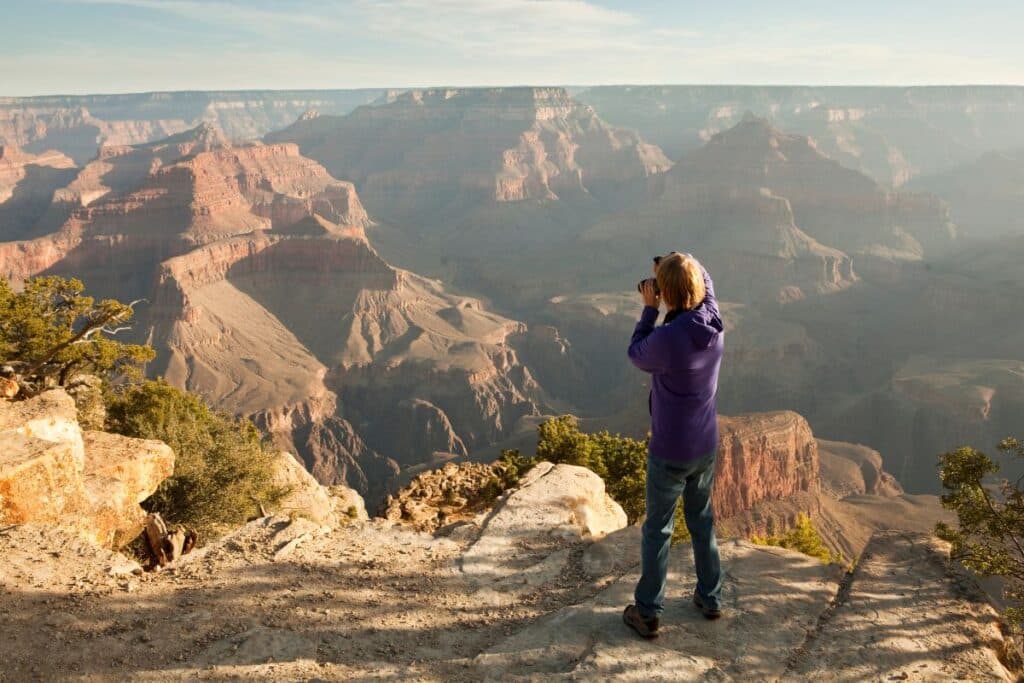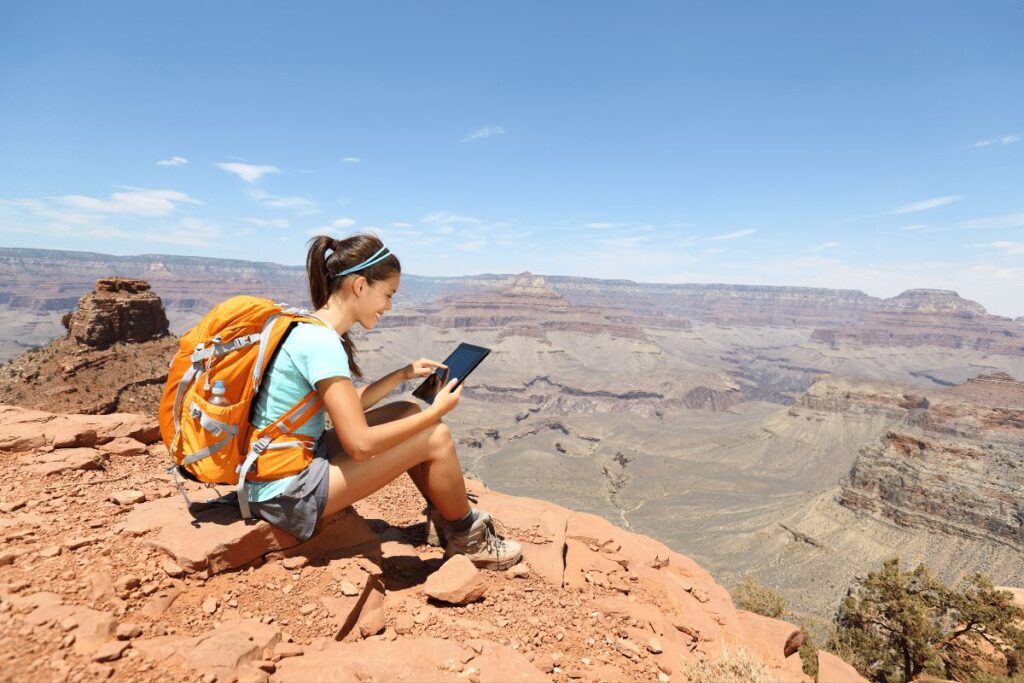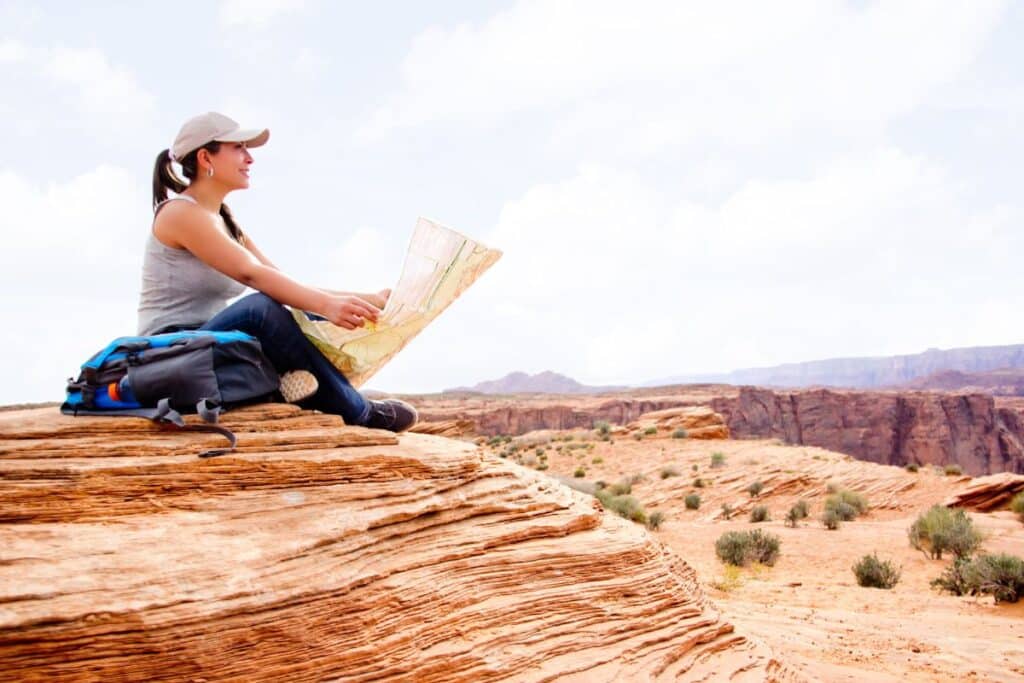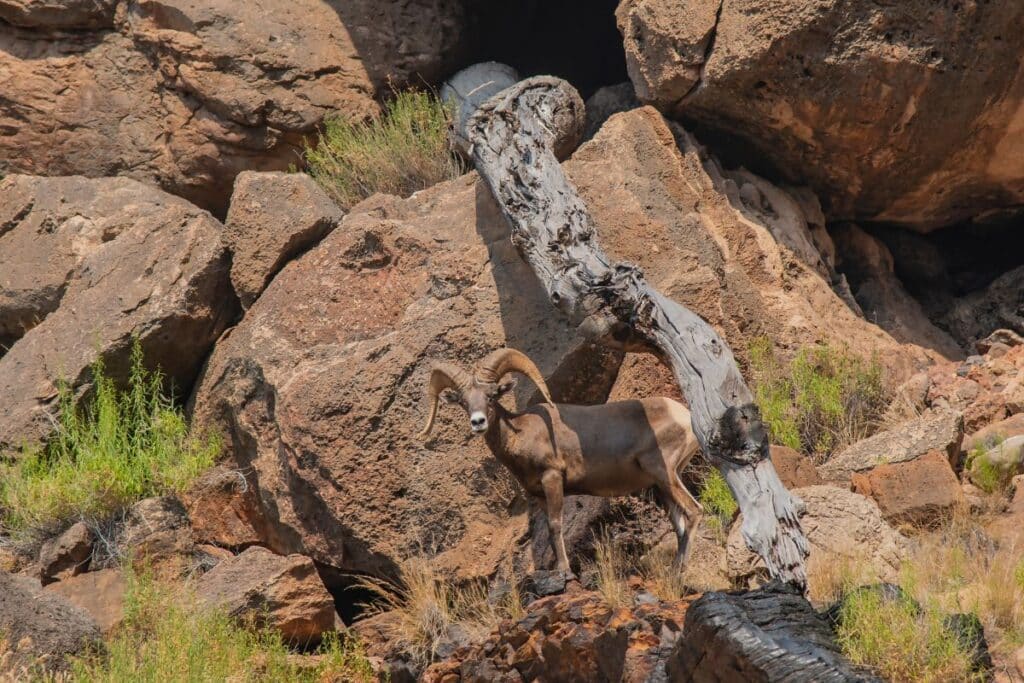Master Photographing the Grand Canyon with our expert tips and guide to the best photo spots. Capture breathtaking views and moments!
Hey, shutterbugs! Ready for an adventure? We’re diving into the awe-inspiring landscapes of the Grand Canyon, armed with essential tips and our favorite spots for capturing its breathtaking beauty.
This guide is all about helping you snag those stunning, once-in-a-lifetime shots. We’ll share insider advice on tackling lighting, angles, and more, to truly do justice to this natural wonder.
And, of course, we’ve got the lowdown on the best places to set up your tripod. Whether you’re a seasoned pro or just starting out, these tips and spots are your keys to unforgettable Grand Canyon photography. Let’s get clicking!
Golden Hour Planning
Planning your visit to the Grand Canyon during the golden hours is a game-changer for photographers. This period, just after sunrise or before sunset, offers a unique quality of light that’s essential for capturing the canyon’s beauty.
The sun, at a lower angle, bathes the landscape in a soft, warm glow. This light deepens the reds and oranges of the canyon walls and highlights their intricate textures.
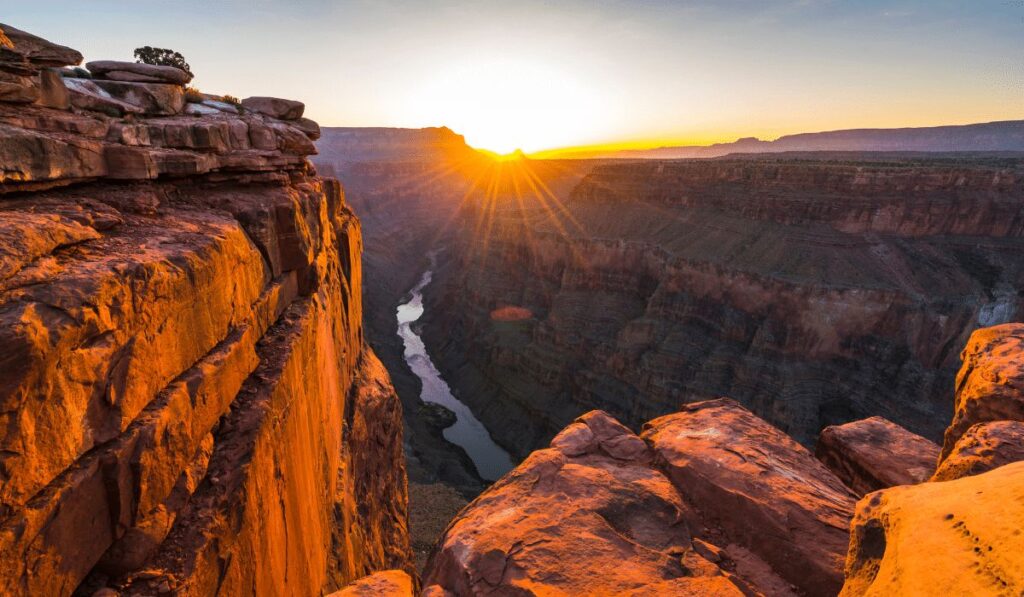
The shadows lengthen, creating a sense of depth and contrast that brings the landscape to life. This time goes beyond just visual appeal, it’s about capturing the canyon in its most dramatic and expressive state.
The golden hour light transforms the canyon, highlighting its grandeur and magnificence in a way that the midday sun cannot. Photographing during these hours is about taking advantage of the natural light to create images that are rich in color, texture, and contrast.
Weather Check Importance
Understanding the Grand Canyon’s weather patterns is crucial for successful photography. The weather significantly impacts the lighting and mood of your shots.
On cloudy days, the canyon’s vibrant colors can appear muted, and the overall photo may lack depth and dimension. Moreover, overcast skies can lead to a blown-out sky in your images, losing details in the brighter areas.
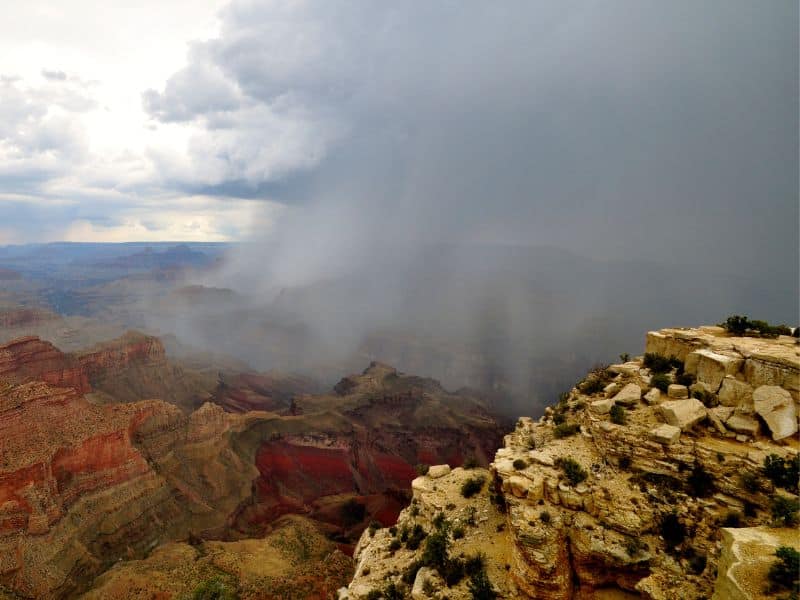
The canyon’s weather can be unpredictable, and sudden changes can pose risks to both your safety and your camera equipment. A storm rolling in while you’re deep in the canyon is not only dangerous but can also damage your gear without proper protection.
Being aware of the weather forecast allows you to prepare adequately, ensuring not only the safety of yourself and your equipment but also enabling you to capture the canyon in the best possible conditions.
Weather awareness is key to adapting your photography plans and maximizing your opportunities to shoot stunning photos of the canyon.
Exploring Angles
In photographing the Grand Canyon, experimenting with different angles and perspectives is crucial to capturing its essence. The canyon, with its vast expanse and varying elevations, offers countless opportunities for diverse shots.
Shooting from high viewpoints allows you to capture the sprawling nature of the landscape, giving a sense of its scale. In contrast, lower angles can emphasize the towering height of the cliffs and the deep gorges, adding a dramatic effect to your photos.
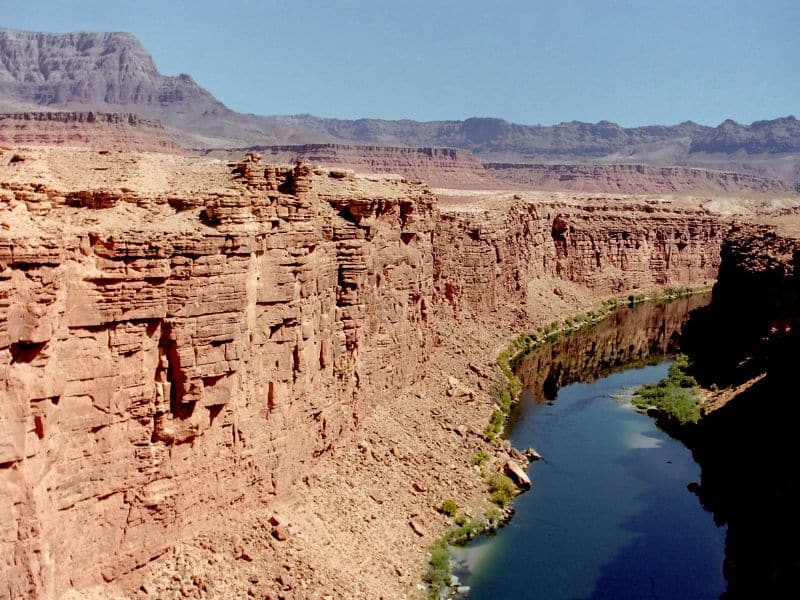
Exploring these different angles is a practical approach to showing the canyon’s magnitude. Each perspective offers a unique view and tells a different story of this majestic landscape.
By varying your angles, you provide a more comprehensive and immersive experience of the Grand Canyon. It’s about conveying the grandeur, diversity, and awe-inspiring beauty of one of nature’s most magnificent creations.
Wide-Angle Lens Necessity
Using a wide-angle lens at the Grand Canyon is not just recommended, it’s essential. The canyon’s vastness is almost impossible to capture in its entirety without this type of lens.
A wide-angle lens allows you to include more of the scene in your frame, making it perfect for expansive landscapes. It helps in showcasing the grandeur of the canyon, from the sweeping curves of the river to the towering cliffs.
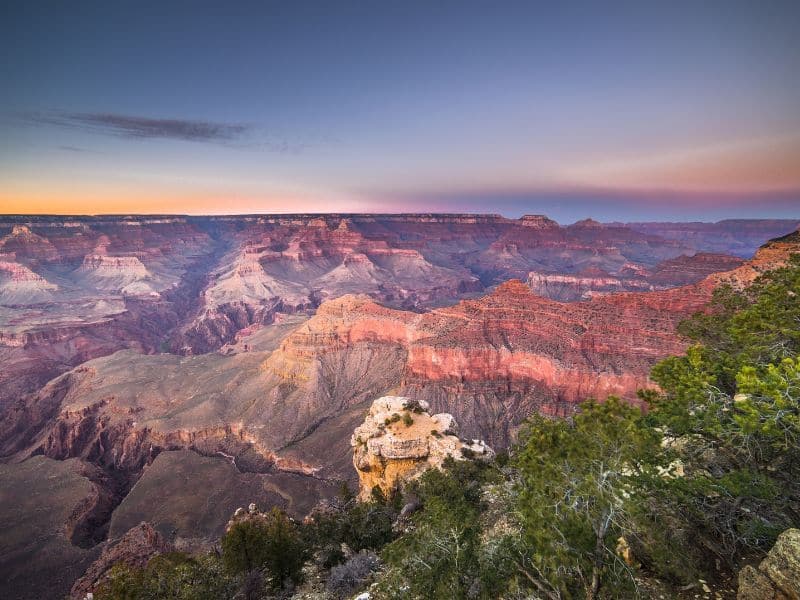
This lens type exaggerates the sense of space and depth, making the viewer feel as if they are there, experiencing the vastness themselves. It also helps in capturing the scale of the canyon, which is difficult to convey in photos.
With a wide-angle lens, you can communicate not just the physical breadth of the canyon but also its overwhelming impact on the viewer.
Foreground Element Inclusion
Incorporating foreground elements in your Grand Canyon photos adds a significant dimension to your compositions. Elements like trees, rocks, or even people provide a sense of scale and depth.
By including something in the foreground, you give viewers a reference point for understanding the canyon’s enormity. This technique is especially effective in landscapes where the vastness can be overwhelming.
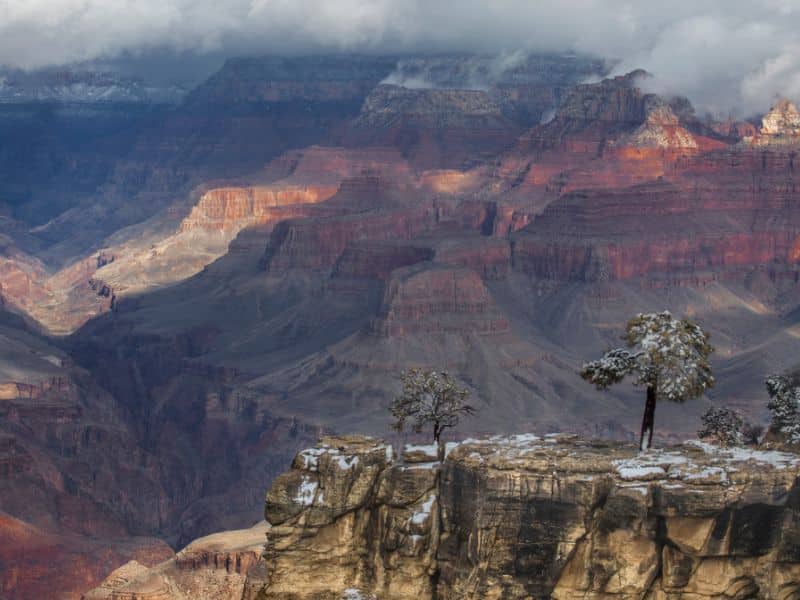
A tree or rock in the foreground can also lead the viewer’s eye into the photo, creating a journey from the front to the back of the image.
When people are included, it adds a human element, making the scene more relatable and emphasizing the grandeur of the canyon compared to the size of a person.
Rule of Thirds Application
The rule of thirds is a fundamental composition technique in photography, and it’s incredibly effective when shooting the Grand Canyon.
By dividing your frame into a grid of nine equal segments and placing important elements along these lines or at their intersections, your photos become more balanced and visually appealing.
This technique helps in avoiding a ‘split-in-half’ look, especially in landscapes where the sky and land are prominent. It creates a sense of harmony and structure in the image, guiding the viewer’s eye through the photo in a natural, pleasing way.
When photographing the canyon, you can place the horizon along one of the horizontal lines, or a significant rock formation or tree along the vertical lines. This method is more than just a guideline; it’s a tool to create engaging, well-composed shots that draw viewers into the scene.
Capturing Weather Dynamics
The Grand Canyon’s ever-changing weather is a spectacle in itself. This natural wonder is renowned for its dramatic weather shifts, which can add an extraordinary dimension to your photographs. Be ready to capture the drama of stormy skies or the serenity of a post-rain rainbow.
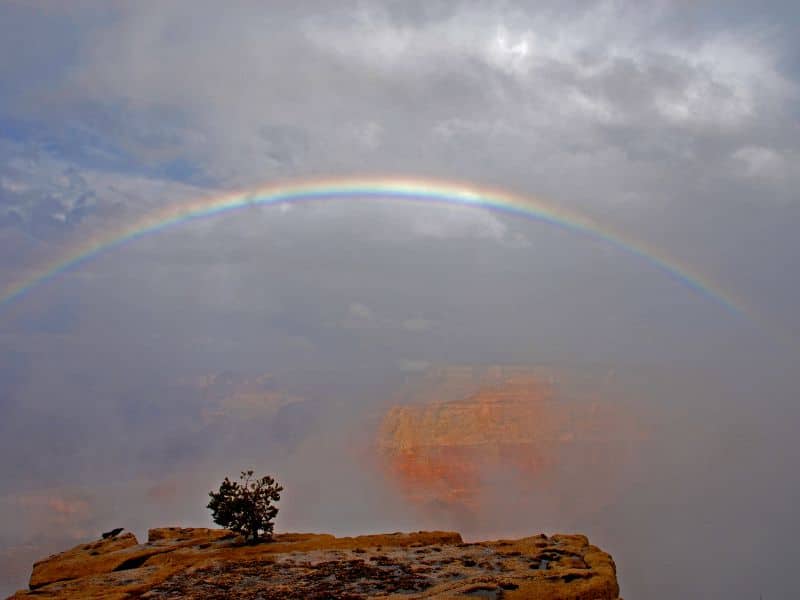
These moments can turn an ordinary scene into a breathtaking display of nature’s moods. Cloud formations, in particular, can transform the lighting and atmosphere of the canyon, making for compelling and dynamic images.
Always have your camera ready, as these weather changes can happen swiftly, offering fleeting yet spectacular opportunities to capture the canyon in a unique light.
Long Exposure Experiments
Long-exposure photography at the Grand Canyon, especially when capturing water elements like waterfalls or the Colorado River, can create mesmerizing effects. Using neutral density filters is key in this process.
These filters allow you to slow down the shutter speed without overexposing the shot, giving water a silky, smooth appearance. This technique is perfect for conveying the sense of movement and flow in the canyon’s rivers and streams.
The resulting images can show a stark contrast between the fluid motion of water and the stillness of the surrounding rocks, adding a surreal quality to your photos. It’s an excellent way to add creativity and a sense of tranquility to your Grand Canyon photography.
Astrophotography Opportunities
The Grand Canyon offers a unique setting for capturing the night sky, making it an ideal location for astrophotography.
The clear, dark skies above the canyon are perfect for photographing celestial wonders like the Milky Way. Nighttime shots here can be truly stunning, with the contrast between the rugged canyon silhouettes and the sparkling stars above.
To capture these scenes, you’ll need a tripod and a camera capable of long exposures. The key is to find a balance between the right exposure and the perfect timing to capture the stars or the Milky Way in their full glory.
This type of photography not only showcases the canyon but also the vast, beautiful universe above it, offering a perspective that is both humbling and awe-inspiring.
Shooting in RAW Format
Shooting in RAW format at the Grand Canyon is crucial for photographers looking to capture the finest details and textures. RAW files act as a digital negative, preserving all the data from your camera’s sensor.
This level of detail is especially beneficial in the varied lighting conditions of the canyon. The biggest advantage comes in post-processing. RAW files provide a much broader range of adjustments in exposure, colors, and shadows without losing image quality.
This flexibility is vital for managing the challenging lighting scenarios often encountered in the canyon, allowing you to fine-tune your images to perfectly reflect the scene’s true beauty.
Foreground Lighting Focus
Paying attention to foreground lighting is essential when photographing the Grand Canyon, especially during the golden hours of sunrise and sunset.
This time provides a warm, diffused light that can dramatically enhance your images. It’s ideal for creating striking silhouettes of the canyon’s formations or for illuminating foreground elements, adding depth and interest to your compositions.
This light can highlight textures and shapes in the landscape, offering a visual richness that can’t be achieved under the harsh midday sun.
By focusing on how this light interacts with the foreground, you can create photos that are not only beautifully lit but also convey a sense of place and time.
Midday Sun Avoidance
The midday sun at the Grand Canyon can be a photographer’s challenge. The intense sunlight during these hours tends to wash out the vibrant colors of the canyon and can create harsh, unflattering shadows.
To avoid these issues, it’s advisable to schedule your photo shoots for early morning or late afternoon. The softer light during these times enhances the natural hues of the canyon and produces more visually appealing shadows.
It results in images that are more balanced, with a greater sense of depth and color richness. By avoiding the midday sun, you ensure that your photographs capture the true essence of the Grand Canyon’s beauty, free from the drawbacks of harsh lighting.
Layered Composition
Incorporating the layers of ridges and plateaus in your Grand Canyon photography is key to showcasing its depth and magnitude. These natural layers create a visual journey from the foreground to the background of your image.
By focusing on these distinct levels, you can convey the immense scale and grandeur of the canyon. Each layer, with its unique color and texture, adds to the overall depth of the photo.
Capturing these layers effectively requires careful composition and angle selection, ensuring that each ridge and plateau stands out, thus illustrating the canyon’s vast, multi-tiered landscape.
This approach not only captures the scenic beauty but also tells a story of geological history and natural wonder.
Patterns and Textures Exploration
The Grand Canyon is a treasure trove of intricate patterns and textures, each telling a part of its geological story. Exploring and capturing these details brings a new level of appreciation and understanding to your photography.
The rock formations, with their lines, grooves, and varied hues, provide a rich tapestry of visual interest. Close-up shots of these patterns and textures can produce striking images, highlighting the canyon’s unique geological features.
This focus on the smaller details adds a layer of complexity to your images, contrasting with the broader landscape shots and offering viewers a more intimate perspective of the canyon.
Exposure Bracketing Technique
Bracketing your exposures is a vital technique when photographing the Grand Canyon, especially given its wide range of lighting conditions.
This method involves taking multiple shots of the same scene at different exposure levels – some underexposed, some overexposed, and some at the correct exposure.
Later, in post-processing, these images can be blended to create a single photograph with balanced lighting throughout. This technique is particularly useful for scenes with high contrast, where the brightest and darkest areas are difficult to capture in one exposure.
By bracketing exposures, you ensure that you capture details in both the shadows and highlights, resulting in a more dynamic and detailed representation of the canyon’s breathtaking landscape.
Simplicity in Composition
When photographing the Grand Canyon, keeping your composition simple can often be more impactful. A cluttered frame can detract from the landscape’s natural grandeur. Instead, aim for a composition that emphasizes the vastness and majesty of the canyon.
This might mean focusing on a few key elements – a prominent rock formation, the curve of the river, or a solitary tree against the vast backdrop. Simplifying your composition helps to convey the scale and beauty of the landscape more effectively.
It allows viewers to appreciate the scene without distractions, drawing their attention to the grandeur and immensity that the canyon naturally presents.
Black and White Experimentation
Experimenting with black and white photography at the Grand Canyon can add a dramatic and timeless quality to your images. Without the distraction of color, the focus shifts to the textures, contrasts, and forms of the landscape.
Black and white images can bring out the stark beauty of the rock formations, the play of light and shadow, and the subtle gradations of the canyon walls.
This approach can transform an already stunning scene into something even more profound and artistic. It’s a way to see the canyon through a different lens, highlighting its rugged and enduring beauty in a classic, evocative way.
Wildlife Capturing
The Grand Canyon isn’t just about landscapes; it’s also home to a variety of wildlife. Capturing these animals in their natural habitat adds another layer to your Grand Canyon story.
From deer and mule deer wandering the rim to the majestic flight of California condors overhead, these wildlife encounters offer unique photographic opportunities.
Photographing animals requires patience and a respectful distance, but the reward is a glimpse into the life that thrives in this harsh yet beautiful environment.
These images can provide a contrast to the grand landscape shots, showcasing the diversity and vitality of the canyon’s ecosystem. Keep your eyes and lenses ready – you never know when a fleeting wildlife moment might present itself.
Panoramic Perspectives
Embracing panoramic photography is a powerful way to capture the sprawling expanse of the Grand Canyon.
This technique, which involves either using the panoramic setting on your camera or stitching together multiple images, allows you to create a wide, comprehensive view of the landscape.
A panoramic shot can encapsulate the vastness of the canyon in a way that standard frames cannot, providing a more complete and immersive view of this natural wonder.
These wide shots can convey the grand scale and the uninterrupted continuity of the canyon, offering viewers a sense of the immense space and beauty that the Grand Canyon embodies.
Seasonal Shifts Photography
The Grand Canyon’s charm varies with the seasons, each offering unique photographic opportunities. Visiting the park at different times of the year allows you to capture this iconic landscape in an array of contrasting settings.
Spring brings wildflowers, dotting the canyon with vibrant colors, while autumn transforms the foliage into a palette of warm tones. Winter can cloak the canyon in snow, offering a rare view of this typically arid landscape, and summer highlights the deep blues of the sky against the rugged terrain.
Photographing the Grand Canyon across these changing seasons not only provides diverse imagery but also reflects the dynamic nature of this ever-evolving landscape.
Aerial Photography Adventure
For a truly unique perspective, consider capturing the Grand Canyon from the air through a helicopter or hot air balloon ride.
Aerial photography offers a vantage point that is simply unattainable from the ground. From above, the canyon reveals itself in new ways – its vast network of gorges, the winding river below, and the interplay of light and shadow across its many ridges.
This bird’s-eye view can provide breathtaking panoramic shots and detailed aerial views, adding a thrilling dimension to your photographic portfolio of the canyon.
It’s an opportunity to see and capture the grandeur of this natural wonder in its entirety, from a perspective few get to experience.
Leading Lines Technique
Incorporating leading lines into your Grand Canyon photography is a technique that adds depth and direction to your compositions.
Natural lines, such as the winding paths of trails, the edges of cliffs, or the flow of the river, can guide the viewer’s eye through the photograph.
These lines create a visual journey from the foreground to the depths of the canyon, enhancing the sense of scale and distance.
Using leading lines is not just about guiding the viewer’s gaze it is also about telling a story and providing a pathway through the vast and complex landscape of the canyon, making the viewer feel as if they are part of the scene.
Top Spots We Go to Photograph the Grand Canyon
When we head out to capture the Grand Canyon’s beauty, these are our go-to spots. Horseshoe Bend wows with its dramatic river arcs, and Havasu Falls dazzles with its turquoise charm.
We love the sweeping views from Mather Point, and catching the sunrise from Navajo Point is always breathtaking. For a unique angle, Ooh Aah Point is a must-visit. Desert View Watchtower offers a historic twist, while Hopi Point is unbeatable for sunsets.
Don’t miss the varied landscapes along The Rim Trail, and for a peaceful escape, Cape Royal is perfect. Each spot is a chance to snap the canyon’s splendor.
Horseshoe Bend
Horseshoe Bend, a spectacular natural wonder just outside the Grand Canyon National Park, is a dream location for photographers. This iconic spot, where the Colorado River dramatically meanders around a rock formation creating a perfect horseshoe shape, offers an unparalleled photography experience.
The best vantage point is from the cliff above, where you can capture the full curve of the river against the backdrop of the vast and rugged landscape.
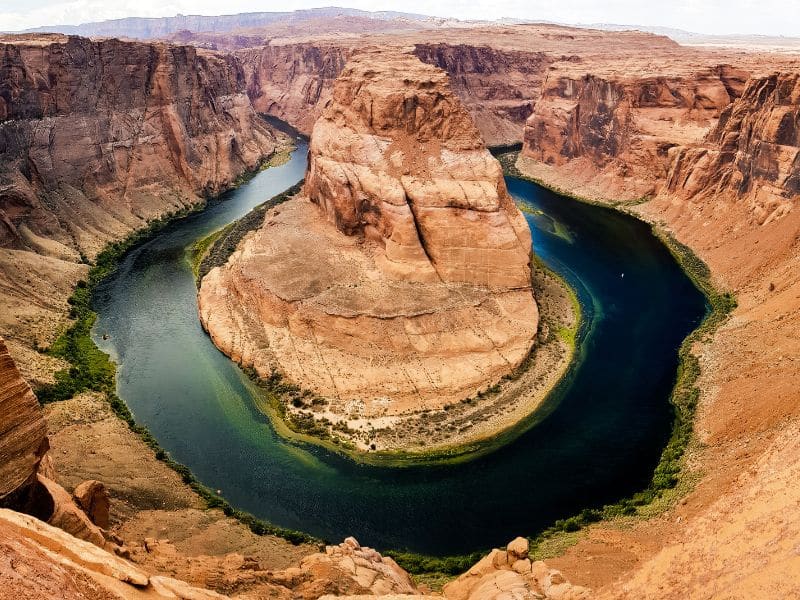
To photograph Horseshoe Bend effectively, a wide-angle lens is essential. It allows you to encompass the entire bend and the surrounding cliffs in your frame.
The scale of the bend, juxtaposed with the mighty Colorado River, can be truly appreciated through this perspective. Timing plays a crucial role here; sunrise and sunset are ideal for capturing the bend with soft, golden light that enhances the reds and oranges of the rock formations.
Long exposure techniques work wonderfully at Horseshoe Bend, especially for smoothing out the river’s waters and capturing the movement of the clouds. This adds a dynamic element to the otherwise static landscape.
Additionally, due to the popularity of this spot, patience is key. Waiting for the perfect light and composition, especially when contending with crowds, can make all the difference in capturing a stunning image of this iconic location.
Havasu Falls
Havasu Falls, a breathtaking oasis nestled within the Grand Canyon’s rugged terrain, is a photographer’s paradise. This stunning waterfall, known for its vivid turquoise waters and striking red canyon backdrop, provides a unique contrast to the typical arid canyon landscapes.
Capturing the essence of Havasu Falls requires an approach that balances the vibrancy of the water with the surrounding natural features.
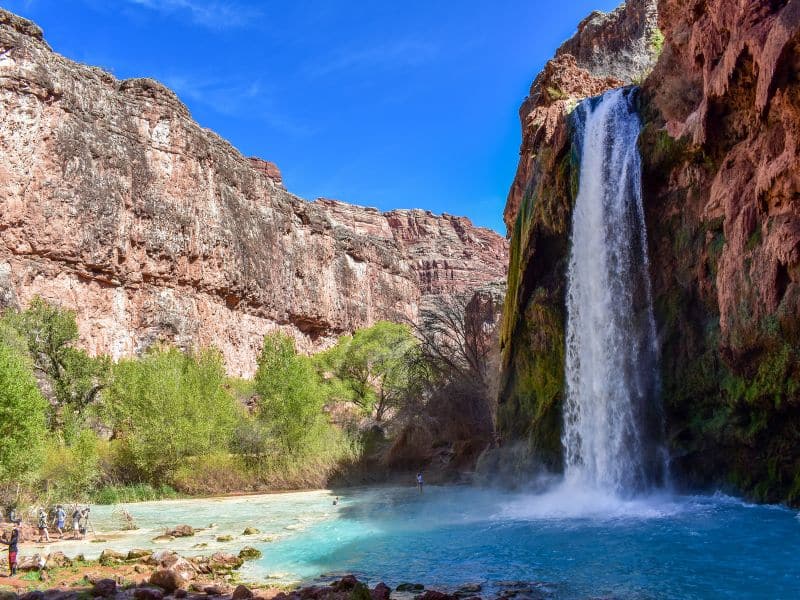
To do justice to Havasu Falls’ beauty, consider using a tripod and a neutral density filter for long exposure shots. This technique allows you to blur the movement of the cascading water, creating a silky smooth effect that contrasts sharply with the static, textured rock formations.
The result is an ethereal portrayal of the falls, emphasizing their serene and almost otherworldly nature.
Photographing Havasu Falls also involves playing with light. The best times to shoot are early morning or late afternoon when the sunlight is softer and casts a warm glow on the water and canyon walls.
This light can bring out the richness of the colors and add depth to your images.
Capturing different angles and perspectives can also enhance your photos. A higher vantage point allows for a comprehensive view of the falls and their surroundings, while a lower angle provides an intimate view of the water’s flow and the intricate details of the rock formations.
Due to the popularity of Havasu Falls, it’s advisable to visit during off-peak times to avoid crowds and capture the serene beauty of this unique location in its full glory.
Mather Point
Mather Point, a prime location within the Grand Canyon National Park, offers photographers one of the most quintessential views of the canyon. Its accessibility and panoramic vista make it a popular spot for capturing the grandeur of this natural wonder.
Standing at Mather Point, photographers are greeted with an expansive view that includes some of the most iconic formations and the meandering Colorado River.
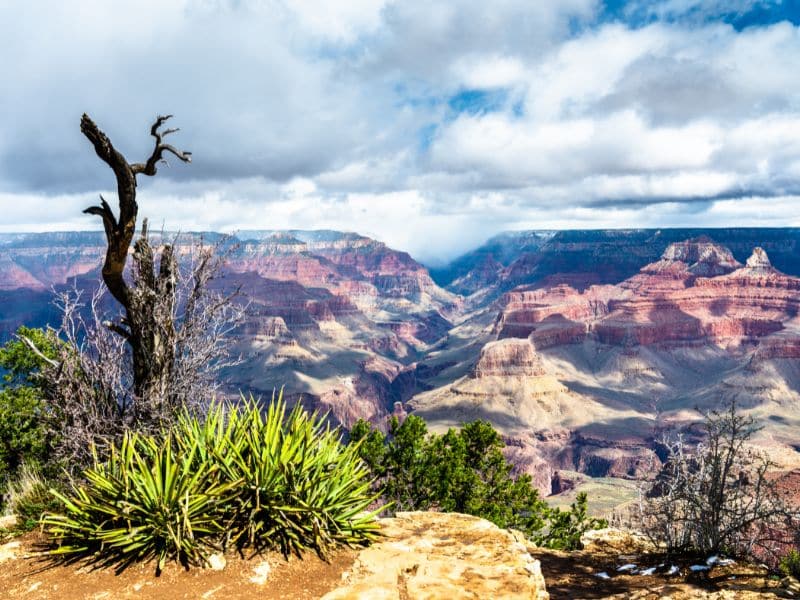
To capture the vastness around Mather Point, a wide-angle lens is indispensable. It allows you to encompass the sweeping landscape, from the dramatic cliffs to the deep gorges.
Early morning is an ideal time to photograph here, as the rising sun illuminates the canyon walls, enhancing their textures and layers. Sunrise also offers a chance to capture the interplay of light and shadow, which adds depth and dimension to the images.
Evening, particularly sunset, is another great opportunity for photography at Mather Point. The setting sun paints the sky in vibrant hues, casting a warm glow over the canyon and creating a picturesque backdrop.
Since Mather Point can be crowded, patience is key. Waiting for the right moment when the light is perfect and the crowds thin out can result in a more serene and unobstructed view of the canyon.
Additionally, experimenting with different angles and compositions, such as incorporating the guardrails or nearby trees as framing elements, can add a unique perspective to the classic Mather Point shot.
Navajo Point
Navajo Point, standing as one of the highest overlooks along the South Rim of the Grand Canyon, offers photographers an exceptional vantage point.
This location provides expansive and less obstructed views of the eastern canyon, making it a superb spot for capturing the grandeur of this natural wonder, especially during sunrise.
The elevation at Navajo Point allows for wide, sweeping shots that capture a vast stretch of the canyon. The early morning light at sunrise is particularly magical here.
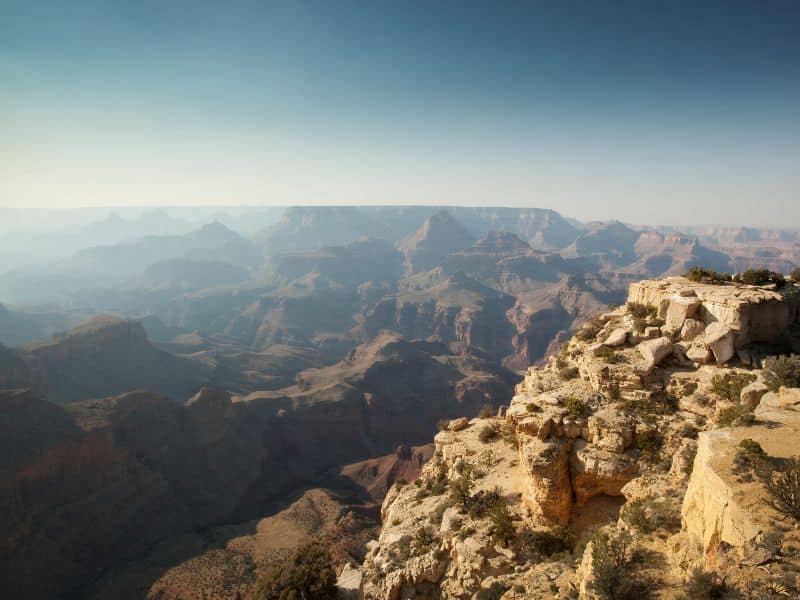
It bathes the landscape in a soft, golden hue, enhancing the intricate layers and textures of the rock formations. The play of light and shadow during this time adds depth and drama to the photographs.
For photographers aiming to capture the vastness and the subtle details of the canyon from Navajo Point, a telephoto lens can be as valuable as a wide-angle lens.
It allows you to zoom in on specific features of the landscape, such as individual rock formations or the river meandering through the canyon floor, providing a different perspective of the grand scenery.
Given its high elevation and open views, Navajo Point is also an excellent spot for panoramic shots. Stitching together multiple images can create a grand panorama that encapsulates the breadth of the Grand Canyon’s eastern expanse.
The key is to arrive early to catch the first rays of light and to experiment with different compositions, capturing both the vast landscape and the intricate details that make Navajo Point a unique location for photographers.
Ooh Aah Point
Ooh Aah Point, aptly named for the reactions it elicits from visitors, is a remarkable spot for photographers trekking along the South Kaibab Trail in the Grand Canyon. This point offers a stunning panoramic view that captures the essence of the canyon’s vastness and beauty.
Its location along the trail ensures a more immersive experience, as it requires some hiking to reach, but the effort is rewarded with breathtaking vistas.
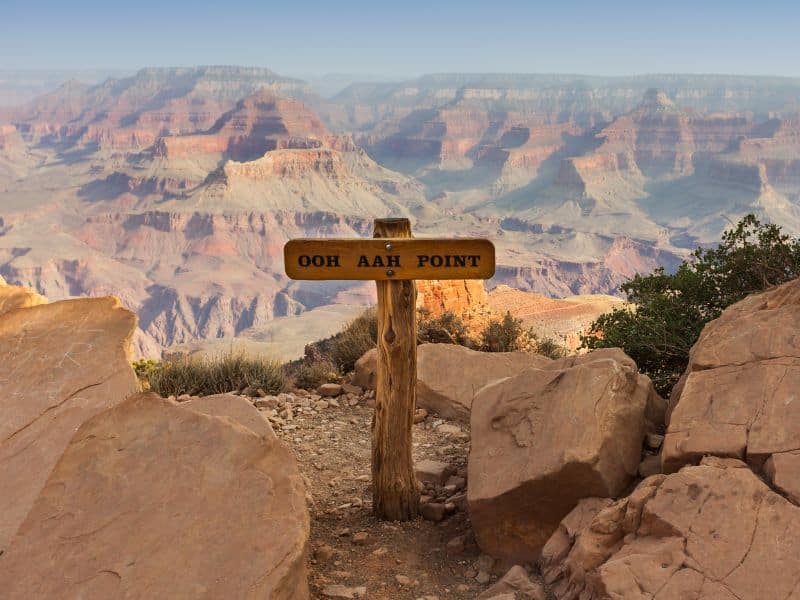
The view from Ooh Aah Point is expansive, providing photographers with a wide-angle perspective of the canyon’s intricate layers and sprawling landscapes.
The point is particularly striking at sunrise or sunset when the light plays dramatically across the canyon walls, highlighting their textures and colors. Early morning light brings out the reds and oranges in the rocks, while the evening light casts long shadows that add depth to the landscape.
For photographers, Ooh Aah Point presents an opportunity to capture the grandeur of the Grand Canyon without the crowds found at more accessible viewpoints.
The key to photographing here is to play with composition, using the natural lines of the canyon to guide the viewer’s eye through the image. It’s also a spot where panoramic shots can be highly effective, allowing you to convey the vastness of the scenery in a single frame.
When planning to photograph at Ooh Aah Point, it’s important to consider the hike’s timing and difficulty, ensuring you have enough time to set up for the best light and to safely return.
The relative solitude and natural beauty of this spot make it a rewarding experience for any photographer seeking to capture the awe-inspiring majesty of the Grand Canyon.
Desert View Watchtower
Desert View Watchtower, located at the eastern end of the Grand Canyon National Park, stands as a unique monument for photographers. This historic watchtower, designed by architect Mary Colter, not only offers a panoramic view of the canyon but also serves as a striking subject in its own right.
The watchtower’s architecture, inspired by Ancestral Puebloan structures, adds a touch of historical and cultural significance to the landscape.
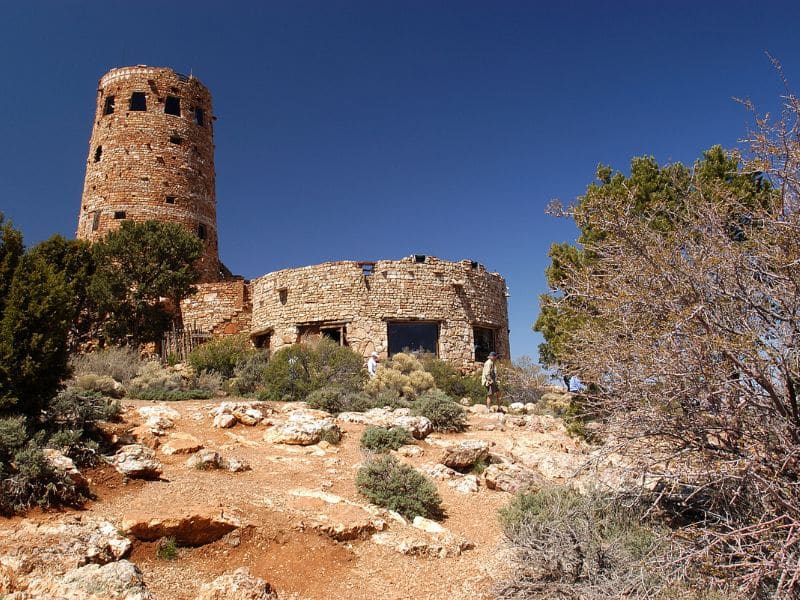
From the top of the watchtower, photographers can capture sweeping views of the canyon, including vistas of the Colorado River and the Painted Desert.
The height of the tower provides a unique perspective, offering a bird’s-eye view that is different from the typical rim shots. Early morning and late afternoon are ideal times to photograph from this vantage point, as the light accentuates the depth and contours of the canyon.
Photographing the watchtower itself, especially during sunrise or sunset, can result in dramatic images. The way the warm or cool light plays on the stone structure, casting shadows and highlighting details, can bring out the texture and character of the building.
In addition to the exterior shots, the interior of the Desert View Watchtower, with its intricate murals and rustic design, offers opportunities for interesting architectural photography.
The windows of the tower frame stunning views of the canyon, creating a unique composition of natural beauty juxtaposed with human-made artistry.
When photographing the Desert View Watchtower, consider using a wide-angle lens for landscapes and a standard or zoom lens for capturing architectural details. Including people in the frame can provide a sense of scale and add life to the images.
The watchtower’s location also makes it a less crowded spot, allowing photographers to take their time to set up and capture the perfect shot of this distinctive landmark and the breathtaking vistas it overlooks.
Hopi Point
Hopi Point, located along the West Rim Drive of the Grand Canyon, is renowned for its extraordinary sunset views, making it a favorite spot for photographers.
The point extends out into the canyon, offering expansive views that include both the northern and southern sides of the chasm, providing a wide canvas for capturing the grandeur of the Grand Canyon.
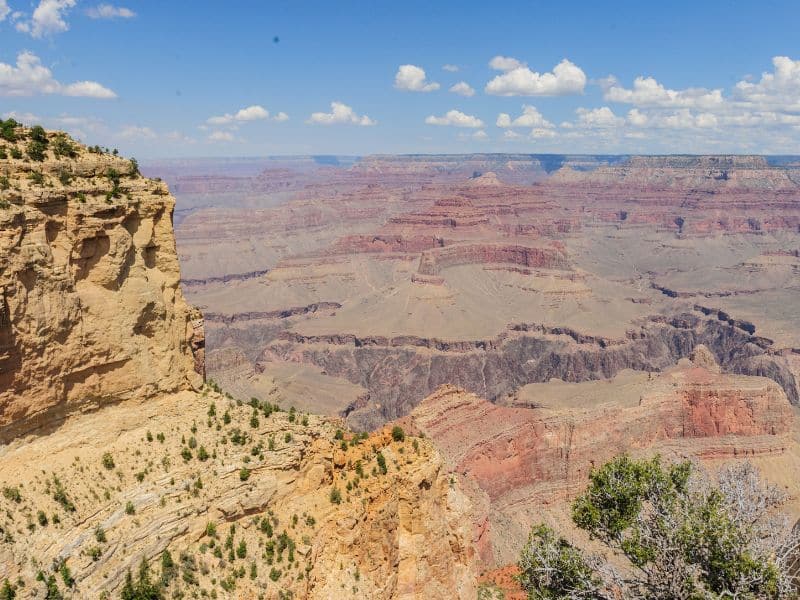
At Hopi Point, the sunset transforms the sky into a spectacular display of colors, with hues of pink, orange, and purple reflecting off the canyon walls. This natural light show enhances the textures and layers of the rocks, creating a dynamic and vibrant scene.
The vastness of the view from Hopi Point allows photographers to capture both the depth of the canyon and the wide expanse of the sky, offering a sense of the immense scale of this natural wonder.
To capture the sweeping vistas, a wide-angle lens is ideal. It can encompass the broad panorama of the canyon and the sky. Additionally, using a tripod can help in achieving sharp, high-quality images, especially in the softer light conditions at sunset.
Hopi Point is also a great location for capturing silhouettes of the canyon’s ridges against the evening sky, adding an element of drama and contrast to your photographs.
The point’s popularity means it can be crowded, especially during sunset, so arriving early to secure a good spot is recommended. Patience and timing are key, as the colors and light change rapidly during sunset, offering a variety of photographic opportunities within a short time span.
The Rim Trail
The Rim Trail, spanning approximately 13 miles along the South Rim of the Grand Canyon, offers a plethora of diverse photography opportunities.
This trail, mostly paved and easily accessible, provides an array of perspectives and compositions of the canyon, making it a paradise for photographers.
One of the most significant advantages of the Rim Trail is its variety of viewpoints and landscapes. Along the trail, photographers can find everything from wide, panoramic vistas to more intimate scenes of the canyon’s intricate rock formations.
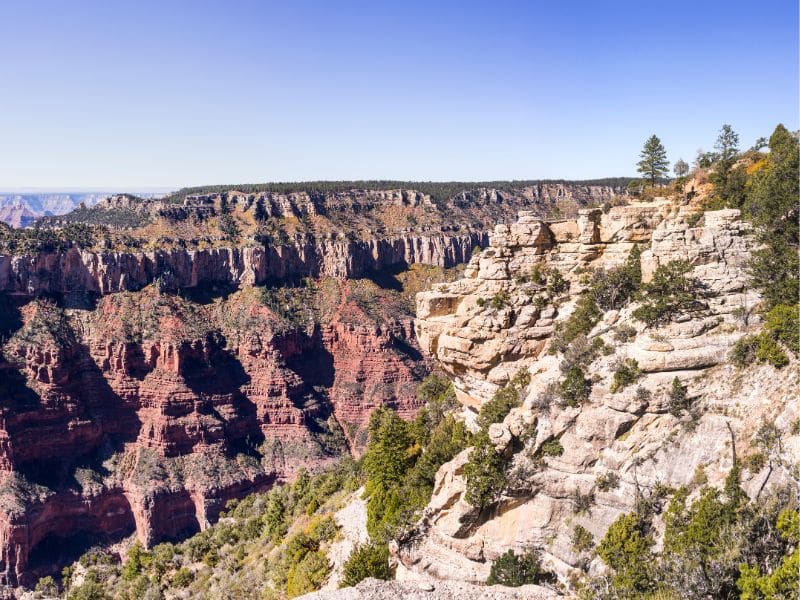
Key photography spots along the trail include Mather Point, Yavapai Observation Station, and Grand Canyon Village, each offering unique views of the canyon.
The length of the trail allows photographers to capture the changing light and shadows over the canyon at different times of the day. Sunrise and sunset are particularly magical, with the changing colors in the sky casting dramatic hues on the canyon walls.
The trail also offers a range of foreground elements, from gnarled trees and wildflowers to historic buildings, which can add depth and interest to compositions.
Another advantage of the Rim Trail is the changing perspectives it offers as you move along. The trail takes you through various elevations and angles, presenting new ways to capture the scale and grandeur of the canyon.
The higher points give sweeping views of the entire landscape, while lower points provide a closer look at the geological formations.
For photographers interested in wildlife and nature, the trail can also be rewarding. The area is home to a variety of wildlife, and the changing seasons bring different natural elements to the forefront, from spring wildflowers to the rich colors of autumn foliage.
Due to the trail’s length, it’s advisable to plan your photography journey in sections. Comfortable walking shoes, plenty of water, and protection against the sun are essential.
A good strategy is to identify specific spots you want to photograph and plan your route accordingly, considering the time of day and lighting conditions.
Cape Royal
Cape Royal, located on the North Rim of the Grand Canyon, provides photographers with a unique and less frequented viewpoint to capture the stunning landscape of this natural wonder.
This spot offers a broad and sweeping perspective of the canyon, encompassing a wide range of geological features and formations.
One of the most striking aspects of photographing at Cape Royal is the panoramic view it offers. The vista includes famous landmarks such as Wotan’s Throne and Vishnu Temple, which stand prominently against the vast canyon backdrop.
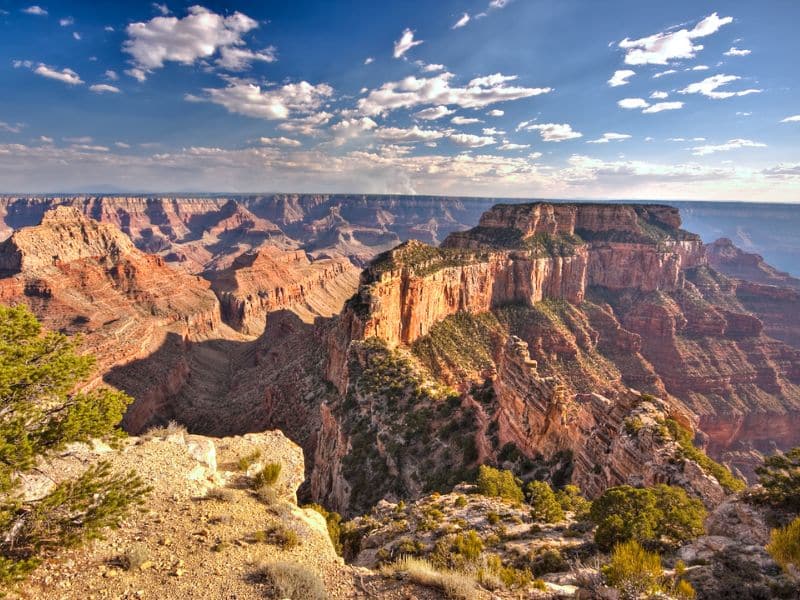
This location is particularly well-suited for wide-angle lenses, allowing photographers to capture the expanse of the canyon in all its glory.
The angle of view from Cape Royal is especially advantageous for sunrise photography. As the sun rises, it illuminates the canyon walls, bringing out the vibrant colors and intricate textures of the rock layers.
The morning light also casts long, dramatic shadows, adding depth and contrast to the landscape.
Cape Royal also presents an excellent opportunity for astrophotography. The remote location and the high elevation of the North Rim result in less light pollution, offering clear, dark skies ideal for capturing the Milky Way or star-laden night skies above the canyon.
Additionally, the relative tranquility of Cape Royal compared to the more crowded South Rim viewpoints provides a more serene photography experience.
Photographers can take their time to set up their shots without the pressure of large crowds, allowing for a more thoughtful and composed approach to capturing the beauty of the canyon.

